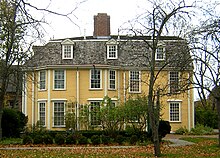Dorothy Quincy
Dorothy Quincy Hancock Scott | |
|---|---|
 Oil painting of Dorothy Quincy, c. 1772 by Copley | |
| Born | May 10, 1747 |
| Died | February 3, 1830 (aged 82) Boston, Massachusetts, United States |
| Occupation | 1st and 3rd First Lady of Massachusetts |
| Successor | Elizabeth Adams |
| Spouse(s) | John Hancock (1775–1793) James Scott (1796–1809) |
| Children | Lydia Henchman Hancock (1776–1777), John George Washington Hancock (1778–1787) |
| Parent(s) | Edmund Quincy (1703–1788), Elizabeth Wendell (1704–1769)[1] |
Dorothy Quincy Hancock Scott (/ˈkwɪnzi/; May 21 (May 10 O.S.) 1747 – February 3, 1830) was an American hostess, daughter of Justice Edmund Quincy of Braintree and Boston, and the wife of Founding Father John Hancock.[2] Her aunt, also named Dorothy Quincy, was the subject of Oliver Wendell Holmes' poem Dorothy Q.[3]


She was raised at the Quincy Homestead in what is now Quincy, Massachusetts. The house in which she lived has been designated a National Historic Landmark, and is known as the Dorothy Quincy House. She married John Hancock, who presided at the formation of the Declaration of Independence in 1776 and was two-time Governor of Massachusetts, in 1775. Their first child, Lydia Henchman Hancock was born in 1776 and died ten months later.[4] In 1787, their son, John George Washington Hancock, was ice skating on a pond in Milton, Massachusetts, and died as a result of drowning when he fell through the ice at age 8. [5]
In 1796, after Hancock's death in 1793, Quincy married Captain James Scott (1742–1809), who had been employed by Hancock as a captain in his trading ventures with England. They lived in Portsmouth, New Hampshire, and had no children together. When Captain Scott died, Dorothy moved back into the Hancock Mansion at 30 Beacon Street in Boston for about 10 years. After that time she lived at 4 Federal Street in Boston.

Dorothy was a well-known hostess, and a great deal was written about her. Many chroniclers of the time note that she was beautiful, well-spoken, and intelligent. She witnessed the Battle of Lexington while staying with her future husband's aunt, Lydia Hancock, at the home of Rev. Jonas Clark, now known as the Hancock-Clarke House.[6] When Hancock told her after the battle that she could not go back to her father in Boston, she retorted, "Recollect Mr. Hancock, that I am not under your control yet. I shall go to my father tomorrow."[7]
References[]
- ^ "Dorothy Quincy (Mrs. John Hancock)". March 14, 2018.
- ^ Cutter, William (1908). Genealogical & Personal Memoirs's Vol II. Lincoln: Nebraska: Lewis Historical Publish Co. p. 594.
- ^ Crawford, Mary Caroline (1902). The Romance of Old New England Rooftrees. L. C. Page & Company. pp. 117. Retrieved March 17, 2008.
- ^ Fowler, William M., Jr. (1980). The Baron of Beacon Hill: A Biography of John Hancock. Boston: Houghton Mifflin. ISBN 0-395-27619-5.
- ^ Fowler1980, pp. 229, 265.
- ^ Wives of the Signers: The Women Behind the Declaration of Independence (1997), Harry Clinton Green, Mary Wolcott Green, and David Barton, pp. 18–32
- ^ Brown, R: "Incidents in the Life of John Hancock: as related by Dorthy Quincy Hancock Scott", Magazine of American History, Vol XIX:1888:506, Barnes, NY
Further reading[]
- Ellen C. D. Q Woodbury: "Dorothy Quincy, wife of John Hancock: With events of her time"; Neale Pub. Co (1905).
External links[]
- Works by or about Dorothy Quincy in libraries (WorldCat catalog)
- 1747 births
- 1830 deaths
- People of colonial Massachusetts
- People from Braintree, Massachusetts
- Quincy family
- First Ladies and Gentlemen of Massachusetts
- Spouses of Massachusetts politicians
